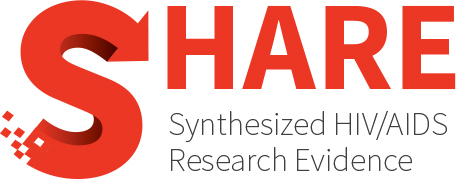Category Archives: Prevention, Engagement and Care Cascade
Guidelines for the transfer of people living with HIV attending primary healthcare facilities in South Africa: A scoping review
People living with HIV may move between health facilities: this is called ‘transfer’, and includes up- and down-referral based on clinical condition and lateral transfer (e.g. between primary healthcare [PHC]...
HIV post-exposure prophylaxis in community settings and by lay health workers or through task sharing: A systematic review of effectiveness, case studies, values and preferences, and costs
INTRODUCTION: Post-exposure prophylaxis (PEP) for HIV prevention has been inadequately promoted, provided and used. Expanded access and task sharing could increase the HIV prevention impact of PEP, but scientific evidence...
User preferences on long-acting pre-exposure prophylaxis for HIV prevention in Eastern and Southern Africa: A scoping review
BACKGROUND: Novel formulations for pre-exposure prophylaxis (PrEP) such as injectables, implants, and intravaginal rings are emerging as long-acting alternatives to daily pills for the prevention of HIV. Eastern and Southern...
Vending machines for reducing harm associated with substance use and use disorders, and co-occurring conditions: A systematic review
Background To stem rising fatal overdoses and other substance use/use disorder (SUD)-related harms, communities are turning to low-barrier harm reduction strategies, such as harm reduction-focused vending machines (VMs) that distribute...
Characterization and stratification of risk factors of stroke in people living with HIV: A theory-informed systematic review
Background Identification and stratification of risk factors for stroke among individuals living with HIV (PLWH) will facilitate primary prevention and prognostication, as well as strategies aimed at optimizing neurorehabilitation. This...
Preferences for long-acting HIV pre-exposure prophylaxis among women of reproductive age in low- and middle-income countries: A systematic review
HIV remains a major public health problem in low- and middle-income countries (LMICs). While oral pre-exposure prophylaxis (PrEP) is documented as safe and effective for HIV prevention, adherence remains a...
What services, interventions and support are available for people with HIV in England to manage their overall health and wellbeing? A scoping review
OBJECTIVES: The average age of a person living with HIV in high-income countries is increasing, as are rates of multimorbidity and frailty. To meet these needs, existing services must adapt....
Ambivalent experiences of people in treatment for tuberculosis-HIV coinfection: A meta-synthesis of qualitative studies
This study examined the scientific literature, by means of a systematic review with meta-synthesis (PROSPERO No. CRD42023410141), to discover the experiences of people undergoing treatment for tuberculosis-HIV coinfection. Ten databases...
Interventions to improve HIV care continuum outcomes for people with HIV who have incarceration experience: A narrative review
People with HIV who are reentering the community after incarceration encounter multiple barriers to engagement in HIV care and treatment. We conducted a narrative review of recent interventions (2020-2023) developed...
How do migrants living with HIV adhere to the HIV care process in high-income countries? A systematic review
BACKGROUND: In high-income countries (HICs), migrants living with HIV (MLHIV) are more likely than other HIV subpopulations to encounter problems which hamper their adherence to the care process; these include...
Magnitude and characteristics of unsuppressed HIV viral load in children and adolescents on antiretroviral therapy in sub-Saharan Africa: A systematic review and meta-analysis
Background: HIV/AIDS remains a major health issue in sub-Saharan Africa, especially among children and adolescents, with a substantial proportion of people with HIV having unsuppressed viral loads despite the availability of...
